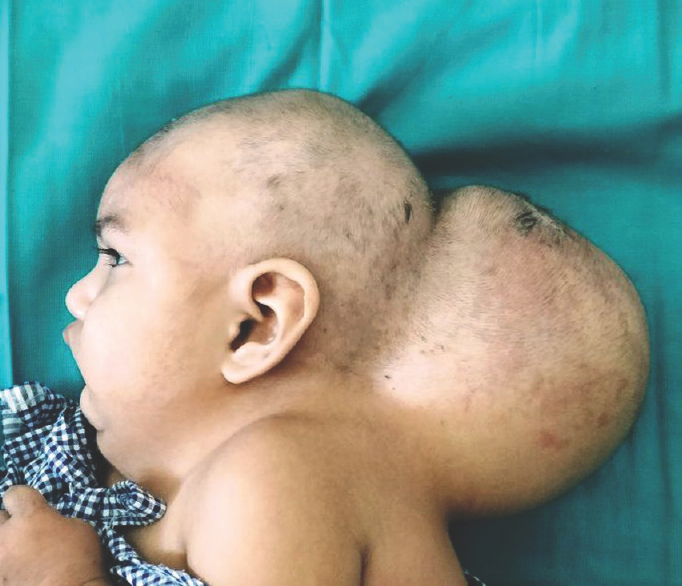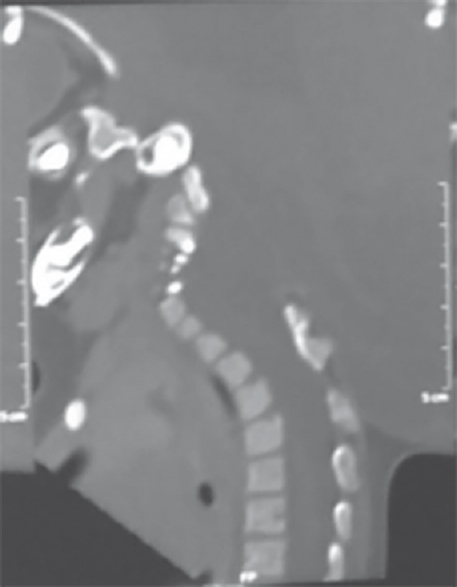Translate this page into:
Giant Occipitocervical Encephalocele
Address for correspondence: Dr. Jitender Chaturvedi, Department of Neurosurgery, All India Institute of Medical Sciences, Rishikesh, Uttarakhand, India. E-mail: drjittu28@gmail.com
This is an open access journal, and articles are distributed under the terms of the Creative Commons Attribution-NonCommercial-ShareAlike 4.0 License, which allows others to remix, tweak, and build upon the work non-commercially, as long as appropriate credit is given and the new creations are licensed under the identical terms.
This article was originally published by Medknow Publications & Media Pvt Ltd and was migrated to Scientific Scholar after the change of Publisher.
Abstract
Encephaloceles are cranial defects in which sac contains herniating brain, which is often gliotic. Congenitally, this defect may extend into posterior elements of cervical vertebrae and leads to occipitocervical encephalocele. When the size of this sac is larger than head size, they are termed as giant. Very young age and associated congenital anomalies in these patients pose significant challenges in diagnostic, anesthetic, and surgical techniques. We share a case of giant occipitocervical encephalocele managed at our institute and discuss about its management issues with review of literature.
Keywords
Encephalocele
giant
hydrocephalus
occipitocervical
INTRODUCTION
Encephalocele represents cranial dysraphism in which herniating sac, through the cranial defect, contains either normal or gliotic brain. It affects 1 in 5000 live births.[1] According to location, they can be divided into either anterior or posterior variant.[2] Posterior or occipital encephalocele is more common. When the head size or occipitofrontal circumference is smaller than the herniating sac, then it is termed as giant encephalocele. Cranial meningocele is the appropriate term when cerebrospinal fluid (CSF) is the only content of the sac. Sometimes, the defect in mesodermal elements, basic cause for encephalocele to form, extends into cervical region leading to occipitocervical encephalocele. This may be associated with features of chiari malformation, in which case, prognosis is skewed toward unfavorable side. We share a case of giant occipitocervical encephalocele at our institute and discuss about its management issues.
CASE REPORT
A 1½-year-old girl brought to the neurosurgery outpatient department of our institute, a tertiary health care center at Rishikesh, India, with a history of swelling at back of her head since birth. She was born in a community health center, near to her home town, at full term as normal vaginal delivery. Since birth, swelling was gradually increasing in size and now giving significant trouble to parents in providing her care for day-to-day life. On examination, as pictured in [Figure 1], she was conscious and playful, moving all limbs equally without any paucity. Her body weight was 7.5 kg. She had cleft palate and micrognathia with low set ears and short and webbed neck although no polydactyly or syndactyly or club foot was noted (usual features of Meckel–Gruber syndrome were partially present). No abdominal mass was palpable clinically. Her head circumference was 46 cm, and anterior fontanel was closed. There was a huge boggy swelling at back of her head extending into upper cervical canal. Size of the swelling was 50 cm × 36 cm, larger than her head circumference, falling into giant encephalocele category. She got evaluated with magnetic resonance imaging (MRI) of brain [Figure 2] with MR venogram (MRV) and computed tomography (CT) head with CT cervical spine. Imaging revealed bony defect not only in infratorcular region of the occipital bone but also in the posterior elements of the atlas, axis, 3rd, and 4th cervical vertebrae as seen in Figure 3. MRV confirmed the transverse sinus or torcula not herniating into the sac. There was no herniation of the brain stem too, into the sac. She underwent surgical excision of the sac and repair of the excess dural and skin coverings. Airway was secured in the supine position with sac supported into a custom-made padded thermocol container box, using fiberoptic intubation. Elliptical incision was used to encircle the sac near the neck, and sac was separated from the overlying skin flap. Although vertical incision can also be used for huge encephalocele, this decision lies entirely on craniocaudal extension of the sac and more importantly discretion and familiarity of surgeon with different techniques. All around the neck of the sac, defective bony margins were identified and excess gliotic tissue excised and CSF was drained. Dura was closed watertight using Prolene 4-0, scalp closed in layers with absorbable sutures, after securing the wound drain. Her body weight was 5 kg in immediate postoperative period suggesting the contribution of sac to be 2.5 kg in her presenting weight. She developed aseptic meningitis in postoperative period, which increased the total duration of stay in hospital; otherwise, she had calm and clement postoperative period. There was no CSF leak from the wound, and mild bulge at operative site was managed with serial lumbar drainages within 2–3 postoperative weeks. However, ultimately, it was decided upon to put a permanent CSF diversion in the form of right ventriculoperitoneal shunt in 5th postoperative week. She was discharged in 7th post-op week with healthy and healed wound, with no fresh neurological deficits.

- Clinical preoperative photograph of the patient in profile, showing the huge swelling at occipitocervical region

- Sagittal magnetic resonance imaging sequence showing giant occipitocervical encephalocele sac with defects noted in the subtorcular region in occipital bone

- Sagittal computed tomography image at craniovertebral junction, absence of posterior elements in first four cervical vertebrae is appreciated
DISCUSSION
Occipital encephaloceles may vary from very small to huge. Bony defects in occipital encephalocele may lie only in occipital bone or it may be extensive enough to involve foramen magnum and even the posterior arch of atlas or vertebrae further down the spine. Herniating brain tissue, more often than not, is nonfunctional dysplastic tissue. Overall survival and long-term neurological functional outcome depends not only on site and size of the defect but also on the status of hydrocephalus and amount of this herniating brain tissue. Having said that, a very large occipital encephalocele containing significant brain tissue with microcephaly is obviously a predictor of very poor neurological outcome.[3] Ventriculoperitoneal shunting is needed in approximately two-thirds of the patients with occipital encephaloceles,[4] irrespective of the preoperative status of ventricle size, as de novo hydrocephalus may develop after surgery. In addition, other congenital anomalies may be seen in up to twenty-five percent of these patients, which may include other neural tube defects, cleft lip/palate, polydactyly, and club foot.[56]
The decision must involve a detailed and extensive discussion with the family and other medical personnel, especially the pediatric neuroanesthetist. Size alone does not provide an adequate idea of the contents, and MRI coupled with MR angiography is the optimal investigation to visualize the contents of the sac and its relationship to venous sinuses.[56] Strict adherence to meticulous neurosurgical techniques of a competent and confident paediatric neurosurgeon, who is aware of the distorted neuroanatomy of his/her patient combined with a vigilant and scrupulous neuro-anaesthesiologist, is bound to give an excellent surgical prognosis. This comes irrespective of huge size of the sac.
Surgical management of these children requires careful attention to pediatric anesthetic and surgical principles. Secondary to removal of a large quantity of CSF, volume and electrolyte disturbances are common which need to be corrected appropriately. Attention has to be given to blood loss, maintenance of body temperature, prone position and its associated complications, and careful securing of the endotracheal tube.[78] The surgical incision would depend on the shape, size, and location of the lesion. Role of a plastic surgeon is always welcome when there is inadequate skin for primary closure for which skin flap rotation or advancement is required. All gliotic and ischemic neural contents can be excised with confidence, taking care of the sinuses that may course through it. Two-layered watertight closure is a desirable important step in surgery. In growing children, osteogenic property of dura is extrapolated, and the need for cranioplasty is eliminated for skull bone defect. Although senior authors recommend CSF shunting prior to excision of giant sac, especially in Chiari III Malformation, absence of pre-op hydrocephalus gave us the confidence to repair the sac first.[9]
In our case, with a tense giant occipital cervical encephalocele, problems encountered were essentially because of the large size and induced pediatric handling, positioning in the MRI gantry, operation theater, intubation, and blood loss during resection of the large amount of redundant skin. The ultimate prognosis depends on the extent and nature of herniated contents and associated anomalies. Even large encephaloceles have an excellent prognosis despite their size.
Declaration of patient consent
The authors certify that they have obtained all appropriate patient consent forms. In the form the patient(s) has/have given his/her/their consent for his/her/their images and other clinical information to be reported in the journal. The patients understand that their names and initials will not be published and due efforts will be made to conceal their identity, but anonymity cannot be guaranteed.
Financial support and sponsorship
Nil.
Conflicts of interest
There are no conflicts of interest.
REFERENCES
- A morphological classification of sincipital encephalomeningoceles. J Neurosurg. 1972;36:201-11.
- [Google Scholar]
- The prognosis of occipital encephalocele. Dev Med Child Neurol. 1967;9(Suppl 13):75-86.
- [Google Scholar]
- Encephalocele and dermal sinuses. In: Cheek WR, Martin AE, McLone DG, Reigel D, Walker M, eds. Pediatric Neurosurgery: Surgery of the Developing Nervous System (3rd ed). Philadelphia: Saunders; 1994. p. :96-103.
- [Google Scholar]
- Subtorcular occipital encephaloceles. Anatomical considerations relevant to operative management. J Neurosurg. 1989;71:375-81.
- [Google Scholar]
- Anaesthesia for paediatric neurosurgery. In: Cottrell JE, Smith DS, eds. Anaesthesia and Neurosurgery (4th ed). Philadelphia: Lippincott Williums and Wilkins: Mosby; 2001. p. :519-20.
- [Google Scholar]
- Large occipito-cervical encephalocele with Chiari III malformation. Journal of Pediatric Neurosciences. 2011;6:116-7.
- [Google Scholar]






